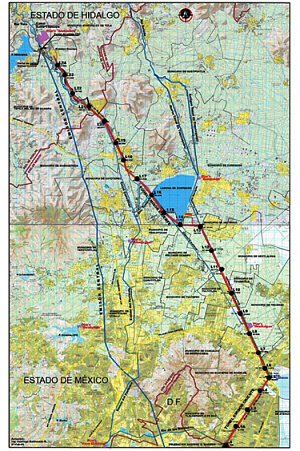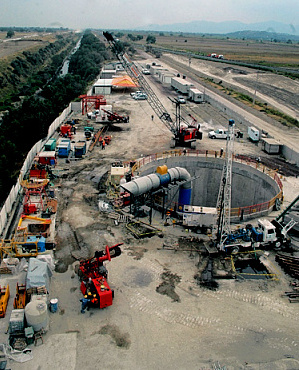As we saw in an earlier post – Attempts to provide drainage for Mexico City date back to Aztec times – Mexico City has serious drainage problems. Because of the shifting subsoil as the land on which the city was built sinks an average of 10 cm/yr, the main drainage tunnels built years ago no longer have the slope (grade) they need to work efficiently. At least one of the feeder tunnels now slopes in the wrong direction!
This has greatly increased the risk of catastrophic flooding occurring. After years of discussion, authorities decided a few years ago that the only viable solution was to construct another major drainage tunnel to take pressure off the existing system and increase the maximum drainage rates following heavy storms.
The new tunnel, known as the Eastern Drainage Tunnel (Túnel Emisor Oriente), is said to be the world’s largest ever drainage tunnel and should be completed within the next couple of years. It is 7 m (23 ft) in internal diameter (wide enough for a tractor trailer) and can carry up to 150 cubic meters of water a second.
The tunnel is 62 km (39 mi) long. It starts from the interceptor channel of Río de los Remedios and ends in a treatment plant in Atotonilco de Tula (Hidalgo), close to where the existing Central Drainage Tunnel flows into the El Salto River. Atotonilco receives 725 million cubic meters of water each year carrying 180,000 tons of garbage. Some of the treated water will be piped to the Mezquital Valley Irrigation District in Hidalgo where water usage exceeds natural replenishment rates. The remainder of the treated water will be given additional (tertiary) treatment before being piped into the overexploited underground aquifers to replenish them.
 The Eastern Drainage Tunnel construction project is one of Mexico’s largest engineering undertakings ever. The total investment (45% government, 55% private) is almost a billion dollars. Six massive boring machines are working in coordination, each boring a 10km section of the tunnel. The work is challenging, partly because of the varied nature of the rocks (limestone, volcanic rock, sand and clay) and partly because parts of the tunnel are as much as 200m (equivalent to 40 stories) below the surface.
The Eastern Drainage Tunnel construction project is one of Mexico’s largest engineering undertakings ever. The total investment (45% government, 55% private) is almost a billion dollars. Six massive boring machines are working in coordination, each boring a 10km section of the tunnel. The work is challenging, partly because of the varied nature of the rocks (limestone, volcanic rock, sand and clay) and partly because parts of the tunnel are as much as 200m (equivalent to 40 stories) below the surface.
One Response to “The Eastern Drainage Tunnel: a solution to Mexico City’s drainage problems?”
Sorry, the comment form is closed at this time.


This is indeed one monumental project that is worth documenting. This also goes to show that the drainage system of an area, big or small, is important in order to prevent flooding and other foundation or underground issues.